By Justin Folks/DWR and Katie Martin/DWR
Photos by Meghan Marchetti/DWR
Ladies and gentlemen, the most wonderful time of year is upon us: deer season! Before we dive into what we might expect for 2023, here’s a quick recap of last year.
2022 Virginia Deer Season Review
During the past deer season 186,788 deer were reported killed by deer hunters in Virginia. This total included 90,349 antlered bucks, 12,117 button bucks, and 83,058 does (44% females).
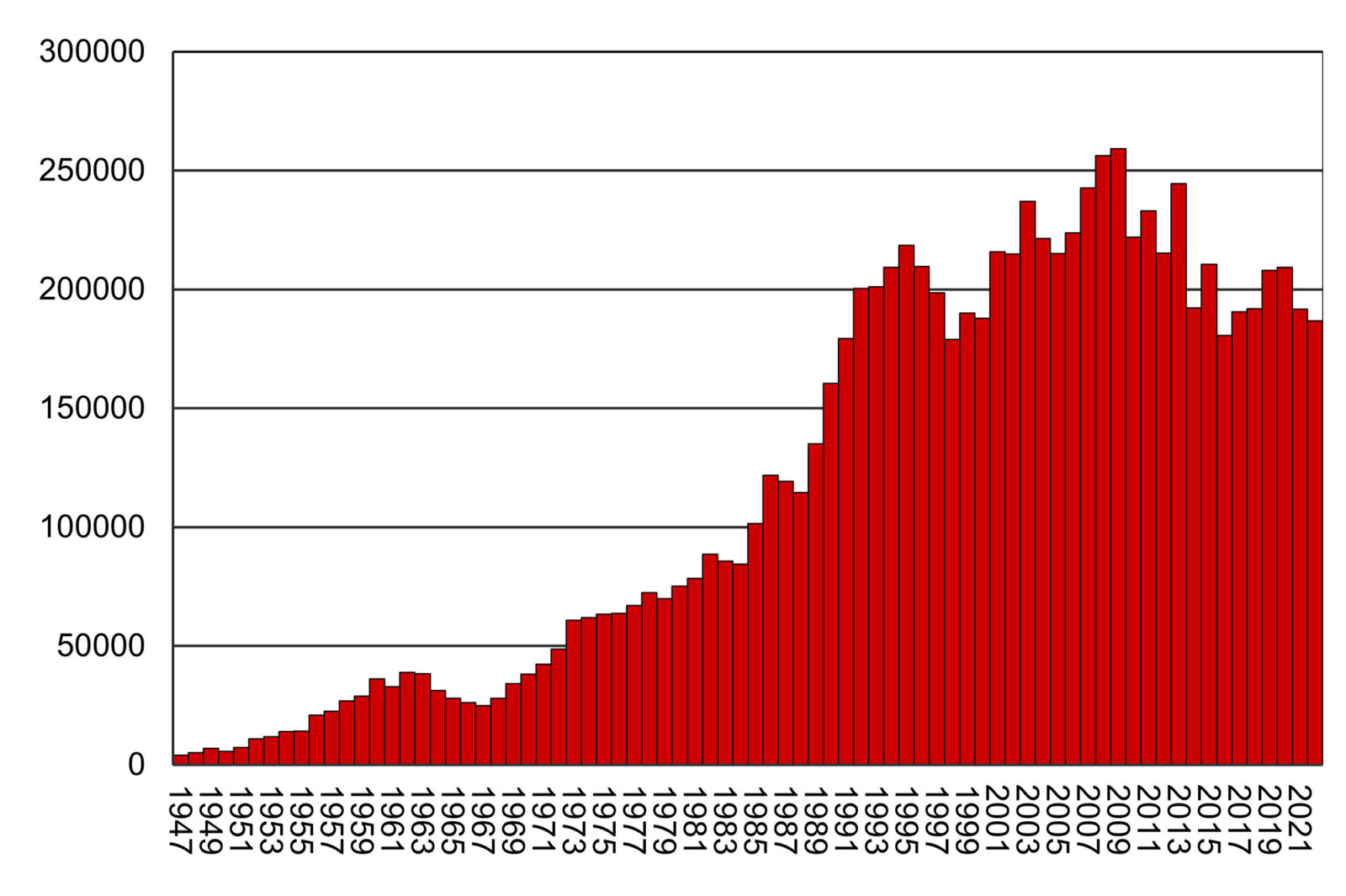
Archery (including crossbows) accounted for 16% of the deer kill; muzzleloaders, 24%; and firearms, 60%. The numbers above do not include deer taken on out-of-season deer kill permits or those deer hit and killed by vehicles. Deer hunters who would like to know the annual deer kill totals by county dating back to 1947, including the county-specific 2022 totals, can find them on the Department’s website (a really cool feature!).
What’s New For Fall 2023
Deer regulations in Virginia are evaluated and amended every other year. This past year was a regulation cycle and hence there are several changes that were adopted by the Board of DWR which will go into effect for the 2023 season.
- An early (September) antlerless-only firearms season has been added on private lands in Carroll, Floyd, Montgomery, and Pulaski counties. These are all counties within CWD disease management area 3.
- An early (September) and late (January-March) antlerless-only firearms season has been added to York County.
- An early (September) and late (through January 31st) antlerless-only firearms season has been added to Bedford County.
- The general firearms season on private lands in Roanoke County has been extended from two to four weeks.
- All cities and towns which allow deer hunting now have a seven-week firearms season.
- The early and late muzzleloader seasons on private lands in Smyth County will be full season either-sex.
- The counties of Lee, Russell, Tazewell, and Wise have added one additional either-sex day during the early muzzleloading season on private lands.
- The counties of Craig, Giles, and Scott will have full season either-sex hunting on private lands during the late muzzleloading season.
- Private lands in Dickenson County will have either-sex deer hunting during the last six days of the late muzzleloading season.
- Earn-a-buck (EAB) has been added to private lands in Augusta, Botetourt, and Page counties.
- EAB has also been simplified to be 1:1 for all counties in EAB, rather than 2:1 in certain counties.
- The antler point restriction (APR) in Augusta County has been removed due to a CWD detection within 25 miles of the county border.
- Either-sex deer hunting days have been increased on private lands in all of the following counties: Bland, Chesapeake, Chesterfield, Gloucester, King George, Lancaster, Northumberland, Nottoway, Richmond, Suffolk (east of the Dismal Swamp Line), Virginia Beach, and Westmoreland. Please see the 2023-2024 Hunting Digest for season dates.
- Either-sex deer hunting days have been increased on public lands in Bland (National Forests), Craig (National Forests & Department-owned lands), Giles (National Forest), Nelson (Tye River WMA), Sussex (Big Woods WMA and Flippo-Gentry WMAs, Big Woods State Forest), Wythe (National Forest & Department-owned lands). Please see the 2023-2024 hunting digest for season dates.
- More counties have been added to our CWD Disease Management Areas (DMAs): Arlington, Fairfax, and Prince William Counties have been added to DMA2, and Patrick County has been added to DMA3.
Disease Management Area (DMA) 1 (Clarke, Frederick, Shenandoah, and Warren counties)
- Mandatory CWD testing will be held in Shenandoah County the first day of the firearms deer season on November 18, 2023. See more details, locations, etc.
DMA2 (Culpeper, Fauquier, Loudoun, Madison, Orange, Page, and Rappahannock counties)
- Mandatory CWD testing will be held in Prince William County the first day of the firearms deer season on November 18, 2023.
- See more details, locations, etc.
DMA3 (Carroll, Floyd, Montgomery, and Pulaski counties)
- Mandatory CWD testing will be held in Carroll, Patrick, and Pulaski Counties the first day of the firearms deer season on November 18, 2023.
- See more details, locations, etc.
Virginia deer hunters should be advised that the CWD management changes enacted above and those adopted in the past will not get rid of or “solve” the CWD issue in Virginia. At best, they will hopefully slow the rate of increase in the prevalence rate in established areas (e.g., Frederick and northern Shenandoah counties) and also hopefully slow the dispersal of CWD from established areas into new areas.
There is still much to be learned about CWD management in white-tailed deer. At this time, there appear to be two major emerging CWD deer population management approaches. First, to reduce deer herd densities by increasing the antlerless deer kill and, second, to increase the buck mortality rate in CWD-affected areas. In addition, it’s important to limit the congregation of deer around artificial food sources (bait piles, feeders, mineral licks, etc.).
Voluntary Statewide CWD Testing
New for the 2023 season, DWR will be offering free CWD testing statewide through use of refrigerator stations at selected DWR offices. Please see our website to see locations of these stations.
Year-Round Feeding Prohibitions
As of July 1, 2023, Augusta and Fluvanna were added to the list of counties with a year-round cervid (deer/elk) feeding ban. Any county within the elk restoration zone and any county within 25 miles of a CWD-positive detection must have a year-round feeding ban per DWR’s CWD Management Plan. Feeding deer is legal statewide from the last day of deer hunting season through September 1 of any year, but prohibiting deer feeding within 25 miles of a known CWD-positive is meant to help decrease the rate of spread of CWD into new areas by not artificially congregating deer. A current map of all Virginia counties with a year-round deer feeding ban is below.
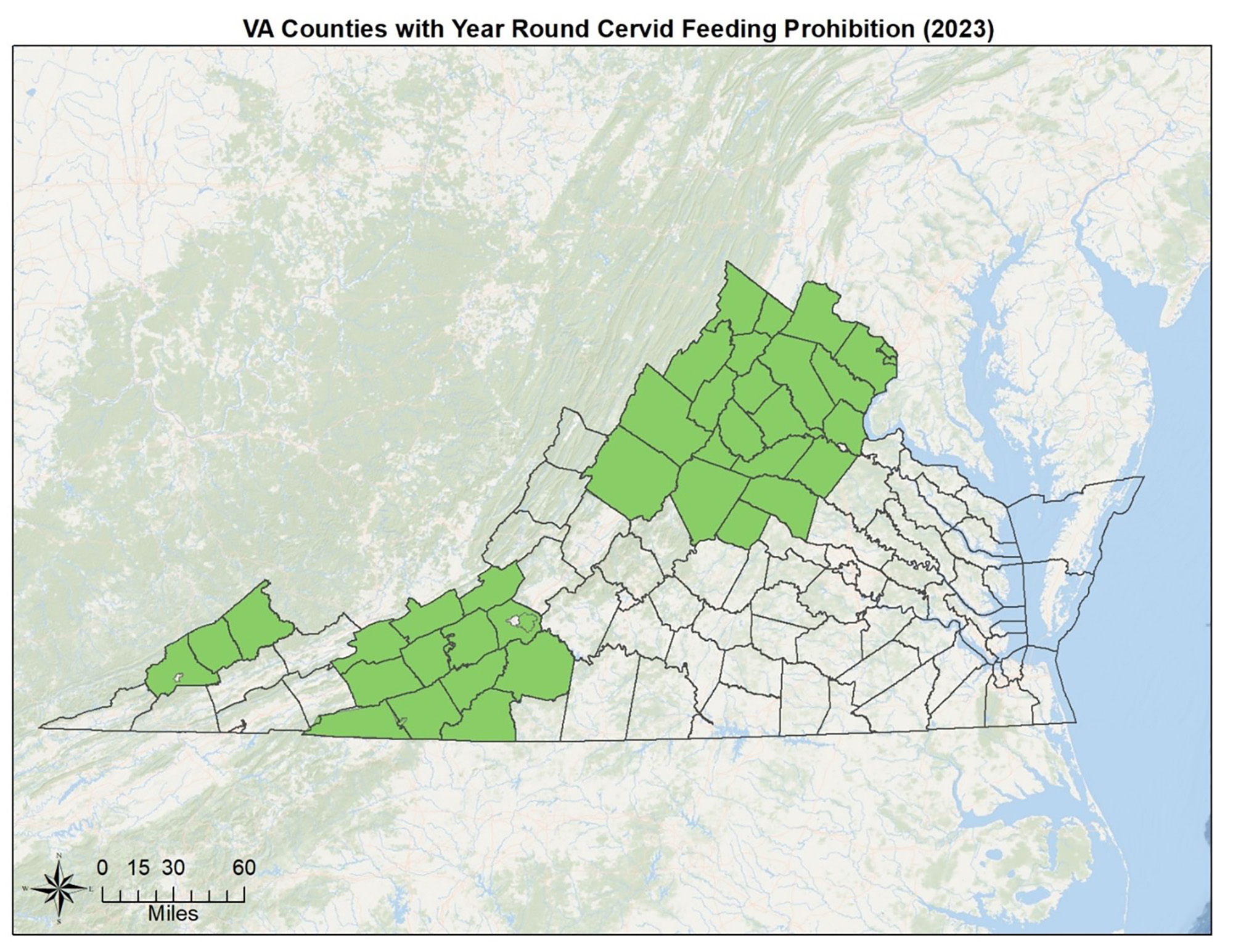
Chronic Wasting Disease (CWD) Surveillance
When the subject is CWD, there is no good news; but the semi-good news in Virginia is that we did not identify any new totally unexpected CWD counties or areas in 2022. While new detections were picked up in Fairfax and Pulaski counties, these were not completely unexpected. Pulaski was already in DMA 3 (along with Carroll, Floyd, and Montgomery) while Fairfax sits adjacent to DMA2. The detection in Fairfax was found ~6.6 miles from the Loudon County border and within 22 miles of a previous detection within Loudon County. Due to the Fairfax detection, Fairfax, Arlington, and Prince William counties will become part of DMA 2. Additionally, due to a detection within 10 miles of the Virginia border in North Carolina, Patrick County will now also become part of DMA 3.
Lastly, please note that mandatory CWD sampling is currently scheduled for the opening day of the firearms deer season on Saturday November 18, 2023, in Carroll, Patrick, Pulaski, Prince William, and Shenandoah counties. Please review the 2023-2024 hunting regulations and the DWR CWD Management website for additional information regarding carcass transport, voluntary testing, and mandatory testing information.
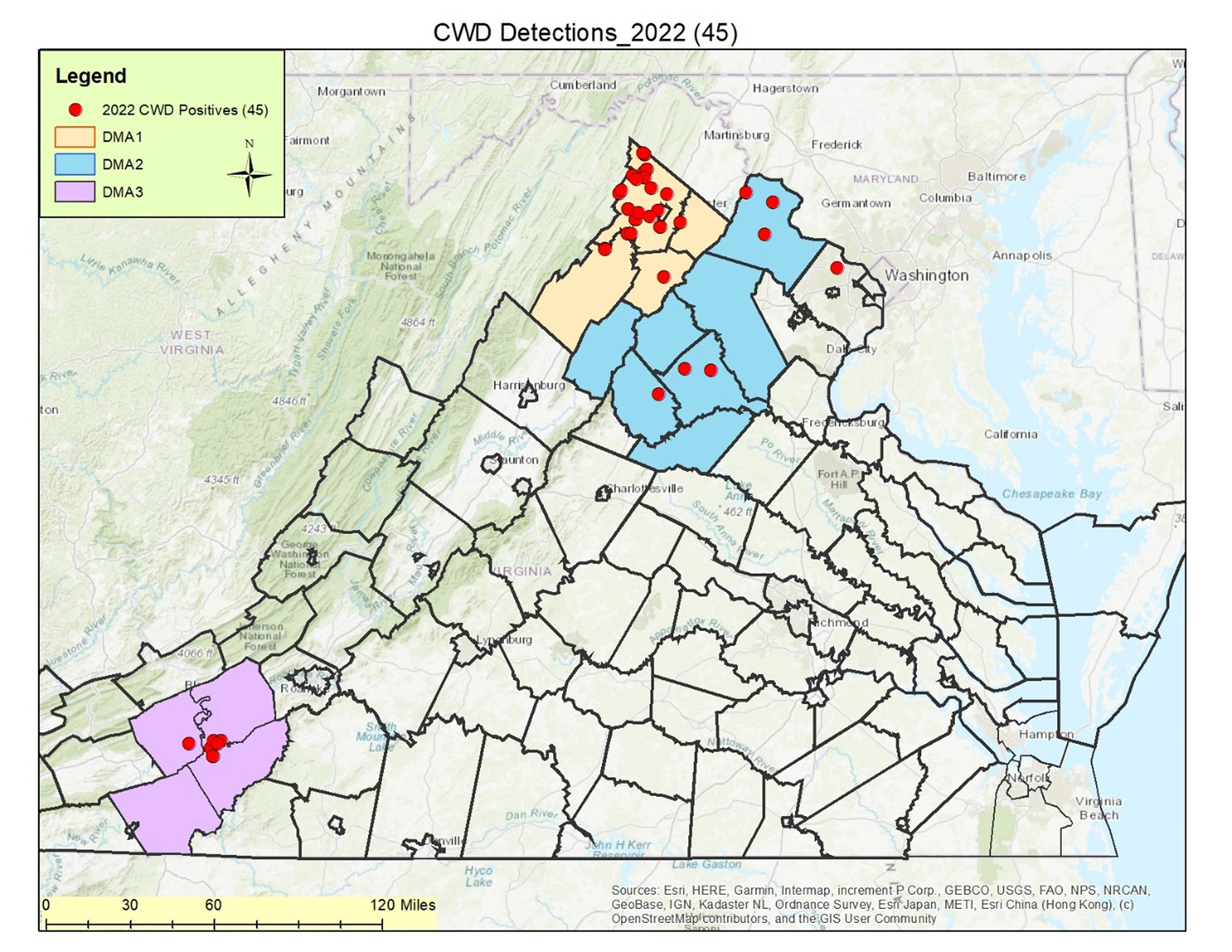
DMA1 (Clarke, Frederick, Shenandoah, and Warren counties)
There are no changes to the boundaries of DMA1 for the 2023 season. During the 2022 season, a total of 444 samples were collected within DMA1, which resulted in 30 positive detections. Frederick County unsurprisingly had the most detections (24), while Shenandoah (4), Warren (1), and Clarke (1) each had at least one detection in 2022.
DMA2 (Arlington, Culpeper, Fairfax, Fauquier, Loudoun, Madison, Orange, Page, Prince William, and Rappahannock counties)
As noted earlier, the boundaries of DMA2 will be expanded for the 2023 season to include the counties of Arlington, Fairfax, and Prince William due to a detection in Fairfax County during the 2022 season. Within the remainder of DMA2 a total of 1,757 samples were taken during the 2022 hunting season. Additional positive detections were found in Loudoun (3), Culpeper (2), and Madison (1). CWD has not been found in Orange or Page counties yet, but it is likely just a matter of time.
DMA3 (Carroll, Floyd, Montgomery, Patrick, and Pulaski counties)
The boundaries of DMA3 will now include Patrick County, due to a detection within 10 miles of the Virginia border in North Carolina. North Carolina sampled heavily throughout the 2022 season in their new CWD surveillance zone, which adjoins Virginia along our DMA3 border. An additional eight positives were detected within this surveillance area in North Carolina, plus one additional positive in southeastern North Carolina. During the 2022 season a total of 1,191 samples were taken within the Virginia DMA3. This sampling effort yielded positive detections in Floyd (3), Montgomery (4), and the first detection in Pulaski (1).
DWR recently unveiled a new online map to assist those hunting in a DMA to find the grid number in which they harvested a deer. This interactive map also shows the locations of sampling sites in their area: CWD Testing Grid Map (arcgis.com)
The rest of the state
In addition to the three DMAs noted above, which currently include 19 counties, the Department continues to conduct annual statewide CWD surveillance outside of the DMAs using a taxidermist-supported CWD surveillance strategy. Adult males are the sex and age class most likely to have CWD, so a taxidermist-supported approach is an efficient CWD surveillance method. In fall 2022, approximately 2,000 samples from hunter-harvested deer were submitted by participating taxidermists. There were no new detections found (aside from Fairfax) from the statewide taxidermist surveillance efforts outside the DMAs.
Hemorrhagic Disease (HD)
Fall 2022 was another fairly quiet HD year. Pockets of HD were reported in the southwest Piedmont (Patrick County), central Piedmont (Cumberland, Goochland, Fluvanna) and several eastern counties (Caroline, Hanover). We also had some HD reports in Rockbridge and Rockingham counties, reminding us that while HD is not as prevalent west of the Blue Ridge, it can still occur. The good news is that decades of experience with HD in Virginia clearly shows that, in the absence of any further significant HD activity, deer herds typically recover in a couple of years.
Lastly, the best predictor for HD activity is summer drought, but this is not a perfect predictor. Based on past experience, HD has the potential to have a major effect on deer herds in eastern Virginia. HD occurs in Virginia every fall at some low level.
For more information on HD go to the DWR HD page or view this informational brochure.
So far in 2023, things have been pretty quiet on the HD front (knock on wood). It’s been an odd year with a dry start to spring, a wet latter half of June, and then a really dry summer (particularly in the northern Shenandoah Valley).
Mast Conditions
2022 gave us an above-average acorn crop across most of the state, making hunting a bit tougher but allowing deer to really pack on the fat for winter. It looks like it’s going to be a different story for 2023 for much of the state. Preliminary reports from our annual mast surveys indicate a pretty poor mast crop, especially for white oaks and chestnut oaks. Red oaks appear to be doing okay, but not spectacular. You may have to hunt hard to find acorns this fall, but if you find some, you should see plenty of activity (at least early in the season).
Drought
Early in the year, conditions were really lining up for an extremely productive season for 2023. A great mast crop last fall sent deer into winter on a higher nutritional plane, we had a mild winter, and we had a relatively wet start to the growing season. However, somebody turned off the rain in many places in the state. The northern mountain and northern piedmont regions have especially suffered this summer from severe drought. Lactating does and weaning fawns key in on eating forbs (non-woody, broadleaf plants) in the summer, but these preferred plants lose nutritional quality or are non-existent during severe droughts. We’ve had plenty of photos of relatively thin deer sent to us this summer from concerned citizens thinking something was wrong with them, but it’s just been a tough summer. Many acorns did not fully develop this year because of the lack of rainfall, contributing to the poorer mast crop.
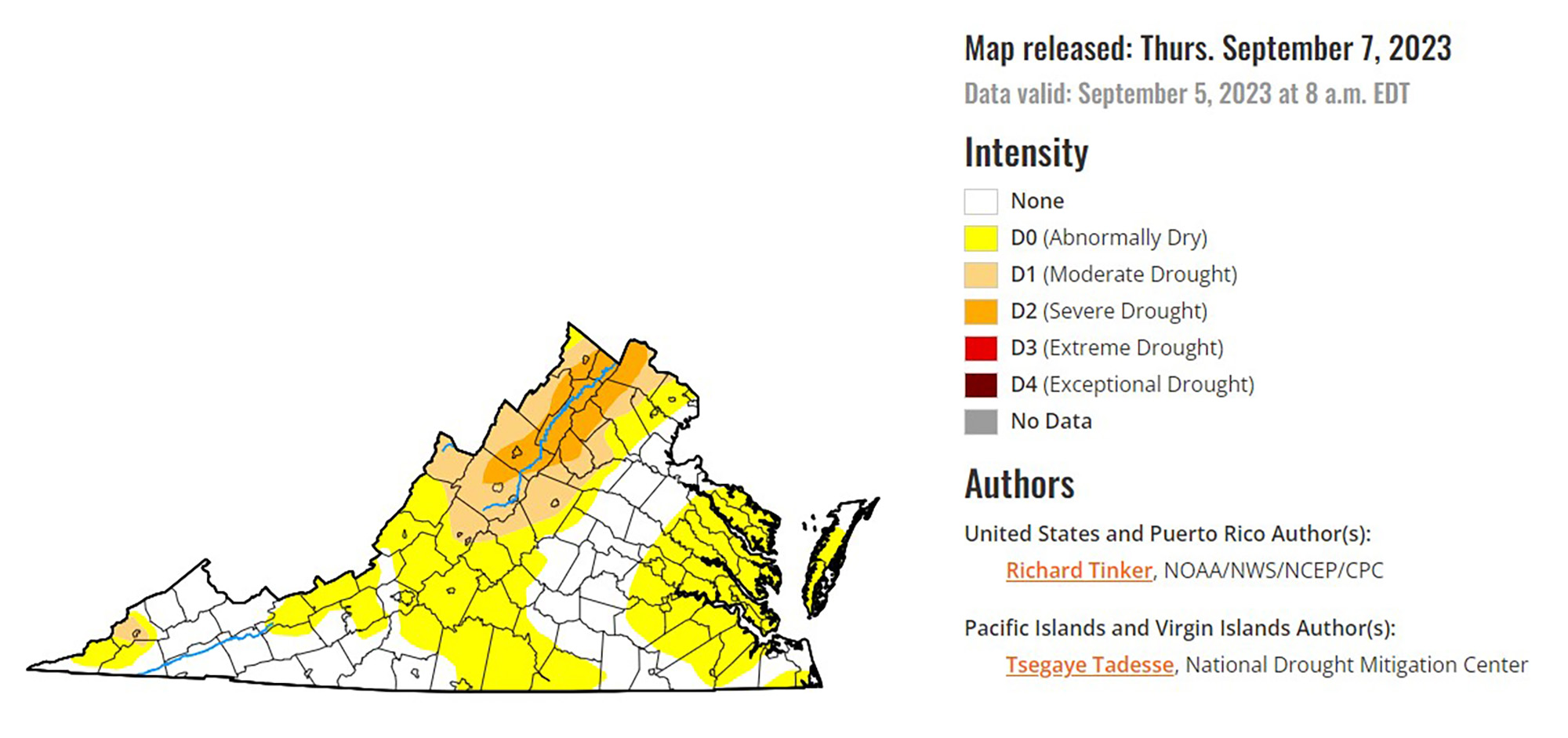
Deer Season Forecasts by Region
Tidewater Forecast
Over most of the past three decades, the deer kill in Tidewater has been fairly stable between 40,000-50,000 deer. The one exception was a period between about 2005 and 2013 when the Department hit the deer herds hard on private lands over much of the Tidewater region with liberal seasons and regulations. Because of this liberalization, the deer kill increased to between 50,000-65,000 annually and these regulations combined with three HD events in 2012, 2014 (big), and 2016 resulted in a decline in the Tidewater deer herd.
Since that time, regulations have been made more conservative in some areas, and deer herds and deer kill numbers across most of the Tidewater region have recovered. If HD is not a big player in fall 2023, stable deer herds are expected across most of the Tidewater Region. Continued high human population growth rates, crop damage, and deer-vehicle collisions remain important deer management issues in Tidewater.
As shown in Figure 4 most deer herds in Tidewater are at moderate (yellow) to moderate to high (orange) deer relative abundance levels and the Department’s current management strategy is either to reduce or maintain deer populations over this region. There is not a deer management unit in Tidewater where the Department is trying to increase the deer population.
Southern Piedmont Forecast
HD hit the southeastern half of the Southern Piedmont like a sledgehammer in fall 2014, but deer populations have recovered since that time. There was a moderate outbreak in fall 2022, but limited to a small geographic area in the southwestern Piedmont. Just like in Tidewater, HD can play a major role in the Southern Piedmont. As long as there is not another big HD event in this area in fall 2023, deer herds over most of this region should be relatively stable.
As shown in Figure 4 about half of the deer herds in the Southern Piedmont are at their desired deer population level (i.e., primarily yellow or moderate). There are a couple of counties in the Southern Piedmont where the Department is actively managing to decrease deer populations (e.g., Bedford, Franklin, and Powhatan) and surprisingly three Southern Piedmont counties where the Department is actually trying to slightly increase the deer herd from low (green) to moderate (yellow) levels (Charlotte, Lunenburg, and Mecklenburg).
Northern Piedmont Forecast
This is the one region where the Department continues to maintain long-term very liberal deer seasons. The female deer kill level has been fairly high in this region for many years. Over most of the Northern Piedmont, the Department continues to try reducing the deer population (see Figure 4), especially in Northern Virginia (Arlington, Fairfax, Loudoun, and Prince William counties) and all of CWD DMA2. For the most part, the ultra-liberal NOVA deer seasons have been successful in controlling deer numbers and reducing deer herds in Loudoun and Prince William. Regrettably, they have not yet resulted in reducing the deer populations to the desired levels.
Stable to declining deer herds are expected and desired moving forward. Continued very high human population growth rates and deer-vehicle collisions remain important deer management issues in the Northern Piedmont. HD can also play an important role in this region.
West of the Blue Ridge Mountains
Deer management in western Virginia has been about the same for the past couple of decades and remains two VERY different deer management situations.
First, deer herds on private lands over most of western Virginia have been fairly stable to increasing over the past two-plus decades (with the exception of Alleghany, Bath, and Highland counties). The last major deer management event west of the Blue Ridge that affected both private and public land was a winter mortality event back in the winter of 2010 due to deep and persistent snow. Relatively stable deer herds are expected on private lands west of the Blue Ridge. If there is a change, hopefully it will be a slight decline, as the productive valley soils on private land yield productive deer herds.
Second, with the obvious exception of CWD in the northern Shenandoah Valley and now the New River Valley areas, the biggest challenge in deer management in western Virginia over the past 20 to 30 years has been, and continues to be, the public land deer management situation. Over the past 25 plus years there has been an approximately 40 percent decline in the number of deer hunters on western public lands (primarily National Forest) and a corresponding 66 percent decline in the deer kill. To address this decline, the number of either-sex deer hunting days on western public lands has been reduced significantly over the past decade or more to conservative levels. These changes have been successful in reducing the female deer kill. The decline in the western public land deer kill has been halted, but the western public land deer population has not and is not expected to recover to past deer population levels unless there is a significant change/major improvement in deer habitat conditions. HD does not traditionally play a major role in deer management west of the Blue Ridge, but with a warming climate, this could change.
Northern Mountains Forecast
As noted at the beginning of this forecast article, CWD is a big issue in the Northern Mountains deer management programs. In every county in the Shenandoah Valley, with the exception of Rockbridge, the Department is trying to reduce deer herds from high (red) and/or moderate to high (orange) deer population levels down to moderate (yellow) deer population levels. Conversely, in the three Alleghany Highland counties the Department is trying to slightly increase deer populations from moderate (yellow) to moderate to high population levels (orange). Approximately two decades ago, all three of these counties exhibited a significant decline in deer populations as a result of habitat changes and a severe winter in 2010. Since that time regulations have been made more conservative and deer populations have stabilized and/or increased. Higher deer populations are desired and tolerated in this area because there are not a lot of deer-human conflicts in this area. There are not many people in the Alleghany Highlands.
Southern Mountains Forecast
The Southern Mountains are best described by three different deer management approaches. In nearly all the counties in the New River Valley area, the Department is trying to reduce deer populations, especially in CWD DMA3. In far southwest, the Department is trying to maintain current/stable deer populations, and lastly in the two of the three coal field counties of Buchanan, Dickenson, and Wise the Department is still trying to increase deer populations. These efforts have been and continue to be successful.
Relative Deer Abundance
The best way to compare deer populations in Virginia is based on the antlered buck deer kill per square mile of estimated deer habitat. Figure 4 shows the relative differences among counties in the kill of antlered bucks per square mile of habitat on private land, averaged over the past three hunting seasons. The current deer population status on private lands is indicated by the base color of the county, ranging from more abundant (red) to less abundant (white). The Department’s deer population management objective for private lands is indicated by the color of the up or down arrow. Counties without an arrow are currently within or at their desired deer population level. This is the best map of “where” deer are in Virginia and “what” deer population level the Department’s Deer Management Plan indicates is wanted for that area. The relative abundance descriptions used above are subjective (e.g., very low/white, low/green, moderate/yellow, moderate to high/orange, and high/red).
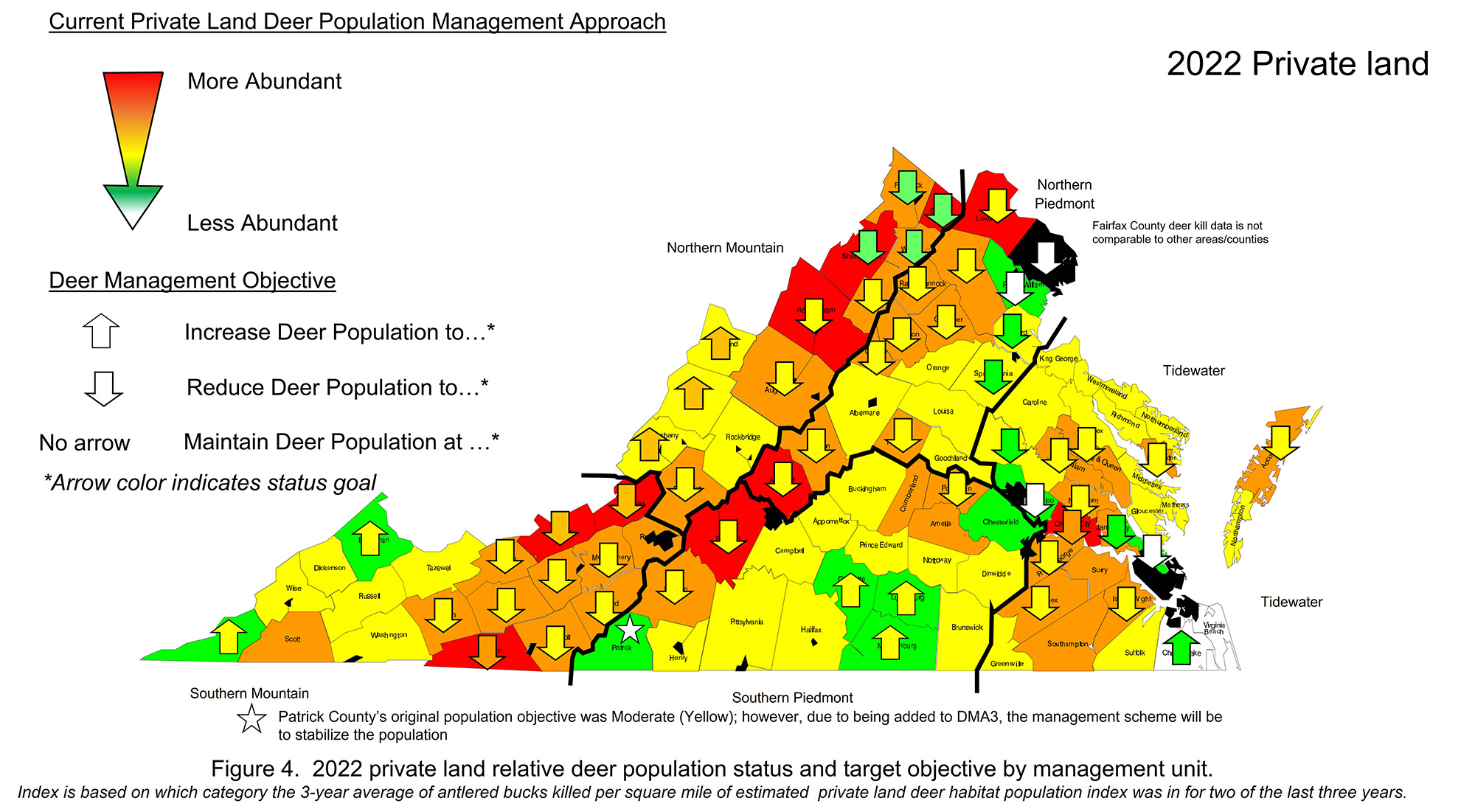
Note there are 97 major deer management units in Virginia. In 46 units, or approximately half of the state, the Department is actively managing to reduce deer populations. In 42 management units, or 43 percent, the Department is actively managing to maintain current deer population levels, and lastly, in only nine management units, is the Department actively managing to increase deer numbers.
Summary
So what is the forecast for the fall 2023 deer season? Unless there is a late, significant HD event, deer populations and the deer kill across most of the state should be stable to increasing. A major increase or decrease in the statewide deer kill total is not expected. Over the past 30 years, the statewide annual deer kill has been relatively stable and ranged from about 179,000 to 259,000 and averaged about 212,300 (see Figure 1).
Past experience indicates that the ups and downs in annual deer kill totals are in part attributable to mast—acorns, mostly—conditions and/or HD outbreaks. In years of poor mast crops, the deer kill typically goes up as deer move more in search of food and are more likely to be seen by hunters. In years of good mast crops, the deer kill typically goes down. We’d expect a slight uptick in total deer kill numbers this fall due to a quiet HD season and a below-average acorn crop.
Persons interested in more information on Virginia’s deer management program can look at the Department’s deer management plan.
Good luck to all this season! Please support the Virginia Hunters for the Hungry program, do not feed the deer, be safe, and introduce someone new to deer hunting this year—the future of our sport depends on it.
Justin Folks is DWR’s deer project leader and Katie Martin is DWR’s deer-bear-turkey biologist.


